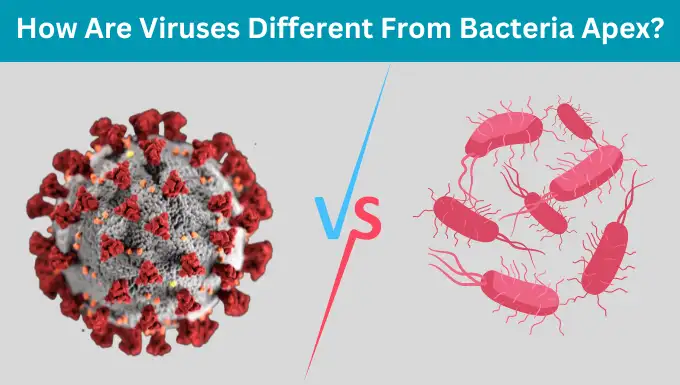Discover the Major differences between viruses and bacteria apex, including their structure, genetics, metabolism, reproduction, and more.
Introduction
Bacteria and viruses, which are among the most abundant organisms on Earth, can cause severe illnesses in our bodies. Understanding how viruses and bacteria work can help prevent and treat related diseases because of their prevalence.
However, viruses and bacteria have distinct biological properties that prescribe their roles and vulnerabilities. Understanding the key differences between bacterial and viral structure, genetics, and reproduction is important for public health efforts against microbial disease.

Basic Biology of Viruses
To highlight differences from bacteria, it is useful to first cover some core viral biology:
Definition
Viruses are acellular microbes that must infect host cells to replicate, causing infection and disease. Unlike cells, viruses lack metabolism and consist only of genetic material surrounded by a protein shell.
Structure
This simple viral structure comprises DNA or RNA genetic material encapsulated by a protein coat called a capsid. Some viruses have an outer lipid envelope from the host cell membrane.
Reproduction
Viruses replicate by infecting living cells and hijacking host cell machinery. The cell makes more viral components, which self-assemble into new viruses that lyse or burst out of the cell.
Basic Biology of Bacteria
Likewise, some key bacterial features include:
Definition
Bacteria are unicellular microorganisms with all structures and metabolic processes needed for life. Unlike viruses, bacteria can thrive and reproduce independently outside of a host.
Structure
Bacterial cells have cytoplasm, and genomes protected by cell membranes and walls. They contain ribosomes and the organelles needed for cellular metabolism.
Reproduction
Bacteria replicate by binary fission, growing to double their size before splitting into two identical daughter cells. Some exchange DNA through horizontal gene transfer.
Table: Major differences between viruses and bacteria apex
| Feature | Viruses | Bacteria |
|---|---|---|
| Cellular Nature | Acellular – lack cellular structure | Unicellular organisms |
| Metabolism | Do not metabolize | Perform all metabolic functions |
| Genetic Material | DNA or RNA genome | Circular DNA chromosome |
| Size | Extremely small – 20-400 nm | Larger microbes – 1-10 μm |
| Reproduction | Hijack host cell machinery | Binary fission of single cell |
| Response to Antibiotics | Not affected | Susceptible and can develop resistance |
| Microscope Visibility | Require electron microscope | Visible under light microscope |
| Structure | Capsid protein shell, may have envelope | Cell wall and membrane, with cytoplasm and organelles |
| Environment | Obligate intracellular parasites | Can live freely outside host |
| Host Specificity | Very specific – often limited hosts | Can infect different hosts |
| Damage | Kill or alter cells | Release toxins |
| Spread | Efficiently spread | Less efficient spread |
Key Differences Between Viruses and Bacteria
Despite both causing disease, viruses and bacteria differ significantly:
Cellular Nature
Viruses are acellular particles, while bacteria comprise fully functional, independent cells. Viruses require a host cell to replicate.
Metabolism
Bacteria perform all metabolic functions necessary for energy production and biosynthesis of molecules using cellular organelles. Viruses only encode a few proteins and do not metabolize on their own.
Genetic Material
Bacteria have circular DNA housed in a chromosome. Viruses contain limited DNA or RNA instructions often housed in a helical capsid. Viral genomes are far smaller than bacterial genomes.
Reproductive Mechanisms
Viruses must invade host cells and hijack their machinery to replicate via self-assembly of viral components. Bacterial cells independently divide to produce daughter cells.
Response to Antibiotics
Antibiotics that target critical bacterial cellular processes are ineffective against viruses, which lack metabolism and infrastructure. This makes viral infections harder to treat.
Diseases Caused by Viruses and Bacteria
Both viruses and bacteria can lead to mild to severe illness:
Viral Diseases
Viruses are responsible for illnesses like rabies, smallpox, hepatitis, influenza, cold viruses, herpes, chickenpox, HIV/AIDS, dengue, West Nile, and COVID-19.
Bacterial Diseases
Bacteria cause diseases like strep throat, staph infections, meningitis, tuberculosis, Lyme disease, tetanus, syphilis, cholera, and bacterial pneumonia.
Fighting Viral vs. Bacterial Infections
Because viruses and bacteria vary significantly, different treatment approaches are required:
Antibiotics Ineffective Against Viruses
Antibiotics only work against metabolically active bacterial cells, not inert viruses. In fact, inappropriate antibiotic overuse against viruses drives resistance.
Antiviral Medications
There are fewer antiviral drugs available compared to antibiotics. Antivirals target pathways like viral entry or replication instead of cellular metabolism.
Immune Response
The body uses very different immune defenses tailored to fight viruses (antibodies, killer T-cells) versus bacteria (phagocytes, IgM, complement).
Preventative Measures
Hygiene, disinfection, and vaccines help prevent both viral and bacterial contagions. However, bacterial spread is easier to interrupt. Many viruses transmit before symptoms arise.
Current Research on Viruses and Bacteria
Ongoing research strives to leverage viral and bacterial biology to help fight disease:
Phage Therapy
Viruses that infect bacteria called bacteriophages are examined as living antibiotics to combat drug-resistant infections.
CRISPR Applications
Bacterial CRISPR immune pathways show promise for antiviral gene editing applications against viruses like HPV and hepatitis.
Microbiome Research
Analyzing symbiotic bacterial roles aids understanding of viral interactions in holo biotic microbiomes that influence wellbeing.
Conclusion – How Are Viruses Different From Bacteria Apex?
While both impact human health, viruses and bacteria diverge significantly in their inherent biological properties as metabolic capacity, structure, and reproduction mechanisms.
Appreciating these key differences provides context for public health efforts aimed at preventing and treating the distinctive infections caused by these prolific microbes.
Ongoing research works to harness new insights from virology and bacteriology to combat disease. With diligence and care, humans can coexist with ubiquitous viruses and bacteria while minimizing the harm they inflict.
FAQs – How Are Viruses Different From Bacteria Apex?
The major differences are that bacteria are complete cellular organisms capable of reproducing independently, while viruses are acellular particles that require a host cell to replicate. Bacteria have cellular metabolism and complex genomes encoding all gene functions, whereas viruses have minimal genomic material focused only on hijacking host cells.
Bacteria can cause disease through releasing toxins that damage host cells, invading tissues, or triggering excessive immune responses in the host. Some key bacterial disease mechanisms include secreting toxins like botulinum toxin, invading through cell adhesion and enzymes, and causing inflammation from lipopolysaccharides in their cell walls.
The primary cause of colds is viruses, specifically rhinoviruses. Bacteria do not directly cause colds, but secondary bacterial infections can sometimes occur due to increased vulnerability from the viral infection. Antibiotics have no effect on colds since the root cause is viral rather than bacterial.
No, viruses cannot turn into bacteria. Viruses and bacteria are different types of microbes. Bacteria are cellular organisms capable of independent reproduction and metabolism. Viruses are acellular particles reliant on host cells for replication.
Two key differences are 1) Viruses are acellular while bacteria are unicellular organisms, and 2) Viruses replicate by hijacking host cells while bacteria can independently reproduce via binary fission of their cellular structure.
Bacteria and viruses are both microbes that can cause human diseases. They resemble each other in their small size and capacity to mutate quickly under the pressure of natural selection.. However, their inherent biological properties are markedly different.
Viruses contain either DNA or RNA as their genetic material. This genetic information is limited to instructions for making more viruses. Bacteria have a full circular DNA chromosome encoding all their genes.
